Adventure! Troop 97
for boys & girls
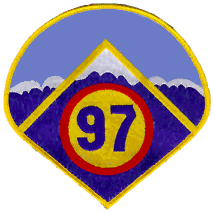
Fort Collins,
Colorado USA
www.troop97.net
![]() HOME—BSA Handbooks & Handbook Covers—Scout Handbook—6th & 7th Editions
HOME—BSA Handbooks & Handbook Covers—Scout Handbook—6th & 7th Editions
6th Edition cover art by Norman Rockwell, painting of a Scout with pack, walking by and waving. The Scout is wearing a red neckerchief as usual, overseas cap, and leggings (for many years in the '50s and '60s, the BSA promoted leggings through their artwork, though these were seldom worn by Scouts outside of the handbooks and catalogs). An interesting error, never detected in seven printings, is the Scout's belt—which is backwards. Due to lack of time, Rockwell painted only the figure itself, someone else filled in the background scene of Scouts hiking and in camp. This is the only Rockwell painting specifically done as a Handbook cover, in honor of the BSA's 50th Anniversary. The back cover continues the scene from the front cover background.
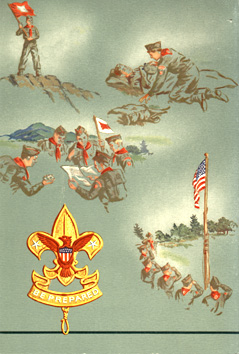
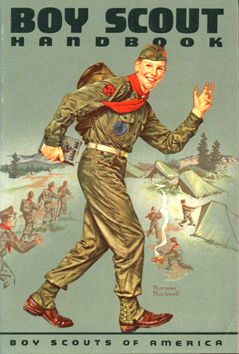
7th Edition cover art (below) by Dom Lupo, painting of Scouts in various hats and neckerchiefs, wearing backpacks and smiling. The background is a camp scene very similar to that of the 6th Edition, also continued onto the back cover.
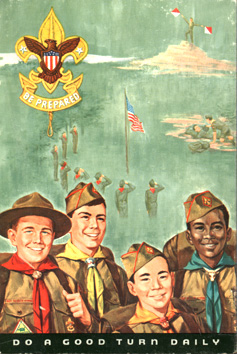
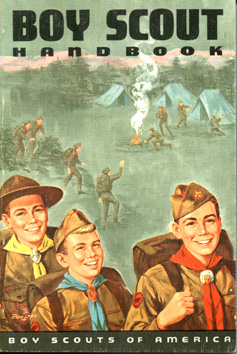
The 6th Edition brought in the modern age of Scout Handbooks, although much has changed since that first multi-colored handbook celebrated the BSA's 50th Anniversary.
For the first time, a Scout Handbook has a single author throughout. For this duty, the BSA selected William "Green Bar Bill" Hillcourt, who had written every Handbook for Scoutmasters since 1936 and every Handbook for Patrol Leaders the BSA had ever had up to that time (the BSA had no guidebook for Patrol Leaders until 1929).
The 7th Edition resulted from a BSA revision of the advancement requirements, but the changes in the Handbook's text and arrangement were minimal. The combined 6th and 7th Editions have the most copies in print of all Handbooks (8.2 million).
These editions are easily distinguished from earlier ones by their larger size and especially by the attractive, full-color artwork throughout. They reintroduce rowing and canoeing, alcohol and tobacco, coffee and tea. The section on lifesaving is reduced to elementary rescues. Early printings have little star information and nothing about poisonous snakes. There is no longer any discussion of tent-making or weather or handicrafts. The 6th Edition has only one illustration of the taut line hitch with no instructions on how to tie it; all other knots are grouped together in another section of the book. The 6th and 7th Editions are the first Handbooks not to contain a listing of the requirements for all merit badges.
The 7th Edition deletes how to measure heights and distances (since these had been removed from the advancement requirements), and it is the first Handbook to state that a saw is a useful tool (only the axe is included in earlier editions). For the first time, BSA started showing non-white faces throughout the handbook, although there is a single isolated drawing of a black Scout in the 5th Edition (the BSA permitted its chartered Scout Councils to operate racially segregated districts and troops as late as 1971).
6th & 7th Editions Summary and Printing History
Combined Total for 6th/7th Editions:
These two Editions were virtually identical in content except for differences related to new advancement requirements.
6th Edition
7th Edition
Actual 6th & 7th Editions Table of Contents
6th Edition
7th Edition
(nearly identical in content to 6th Edition, but table of contents expanded)
Last Revision to This Page: 27 April 2013
Text copyright © 1980, 1990, 1999, 2009 by Jeff Snowden
Web format © 1996-2013 by Troop 97 BSA
Handbook pictures copyright © by Boy Scouts of America